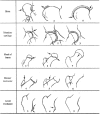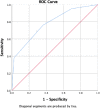Predicting subsequent contralateral slipped capital femoral epiphysis: an evidence-based approach
- PMID: 32351620
- PMCID: PMC7184641
- DOI: 10.1302/1863-2548.14.200012
Predicting subsequent contralateral slipped capital femoral epiphysis: an evidence-based approach
Abstract
Purpose: The purpose of this study was to identify risk factors for developing a subsequent contralateral slipped capital femoral epiphysis (SCFE) and provide a prediction score to quantify risk of subsequent slip at the time of initial presentation.
Methods: This retrospective study included patients that presented with a unilateral SCFE between 2006 and 2017. Chart and radiographic review were performed to collect demographic, clinical and radiographic risk factors. Descriptive statistics, univariate analyses and multivariate regression analysis were used to compare risk factors between patients that did or did not develop a subsequent contralateral SCFE.
Results: This study included 183 patients and 33 patients (18%) developed a subsequent contralateral SCFE. Younger age at time of initial presentation, lower modified Oxford Score and smaller difference in epiphyseal-diaphyseal angle between both sides during index presentation were significant predictors of subsequent contralateral SCFE. Specifically, age ≤ 11 years, modified Oxford Score ≤ 20 and difference in epiphyseal-diaphyseal angle of ≤ 21° between both hips were predictive of a contralateral slip (Area Under the Curve = 0.78; p < 0.05). The presence of each risk factor increased the risk of subsequent contralateral SCFE and having all three risk factors increased the risk to 73%.
Conclusion: There is a significant risk of subsequent contralateral SCFE in patients with unilateral SCFE, and predictive risk factors include younger age, lower modified Oxford Score and smaller difference in epiphyseal-diaphyseal angle between the affected and unaffected hips.
Level of evidence: Level III.
Keywords: contralateral slipped capital femoral epiphysis; prediction score; prophylactic pinning; slipped capital femoral epiphysis.
Copyright © 2020, The author(s).
Figures



References
Publication types
LinkOut - more resources
Full Text Sources
Research Materials

